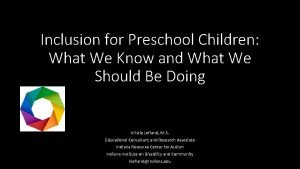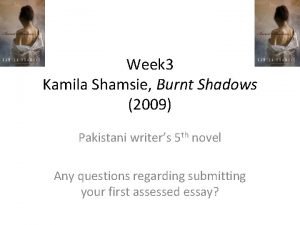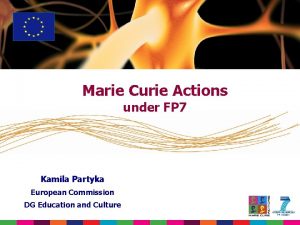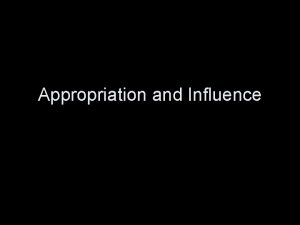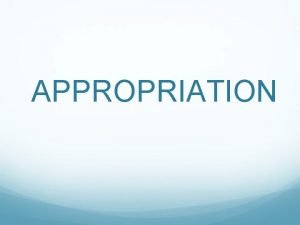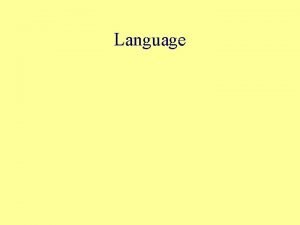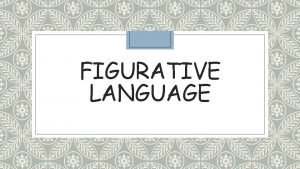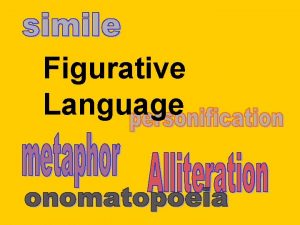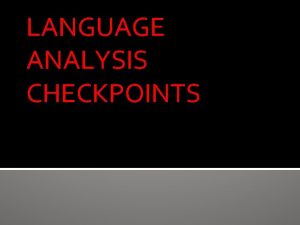Language appropriation A strategical analysis of Kamila Shamsies
















- Slides: 16

Language appropriation: A strategical analysis of Kamila Shamsie’s Salt and Saffron Shehnaz Mehboob Zainab Akram Hajra Masroor

Introduction �The study investigates the usage of strategies of language appropriation in a postcolonial text Salt and Saffron. �As English is the lingua franca of the world and spread in every continent, it has undergone alterations in lexical, syntax and phonological levels thus giving rise to New Englishes. � Hence, the post colonial critics and writers appropriate English to their own use and form their identities.

Objectives of the Study 1. To find the reason behind appropriating languages by the postcolonial writers. 2. To analyze the language appropriation techniques are employed by Shamsie in Salt and Saffron. 3. To find the novelty in the usage of appropriation techniques in Salt and Saffron.

Questions The study tried to answer the following questions: Q 1. What is the reason behind appropriating languages by the postcolonial writers? Q 2. How many language appropriation techniques are employed by Shamsie in Salt and Saffron? Q 3. What is the novelty in the usage of appropriation techniques in Salt and Saffron?

Methodology The strategies of appropriation that the postcolonial writers are using have been studied by Kachru (1983) and Ashcroft, et al. (2002) are: � glossing, � untranslated words, � syntactic fusion, � lexical innovation, � contextual redefinition and � code-Switching. � Population Researchers have selected novels of kamila shamsie for analyses. � Sample Researchers have selected one novel of Kamila Shamsie’s, titled as Salt and Saffron.

Data Analysis Glossing: � It is a brief marginal notation of the meaning of a word in a text. It may be in the language of the text or in the reader's language if that is different. � Writers deliberately use glossing in their writings in to aware their readers with the meaning of the word without translating it in English but by giving explanation to it. � Glossed words convey meaning more than English words in the context it is used. � For example, Shamsie (2000) in her novel use a word “kathak”. Kathak is one of the eight forms of Indian classical dance. � When I was very young she had taken me to a kathak performance. It was my first experience of classical dance and ………. Which accompanied with table and bells- the ghungroo. (p. 116) � “Qaida, Saleeqa”(p. 36) is another example of glossing. In the text “Manners above all. Qaida. Saleeqa. Hadn’t anyone ever taught her that? ”

Un-translated words � In postcolonial texts, this political act of leaving the words untranslated indicates that the text is written in an ‘other’ language. The technique of leaves some words un-translated in the text is a more widely used device for conveying the sense of cultural distinctiveness. � Such a device not only acts to signify the difference between cultures, but also illustrates the importance of discourse in interpreting cultural concepts. In the post-colonial text the absence of translation has a particular kind of interpretative function. � Kamila Shamsi use un-translated words extensively. She uses the word Shaitan (p. 75), without translating into its English equivalent devil. � “Leave, leave, before you make me into an instrument of shaitan and I send you to hell. ” The story of the novel is based on a Muslim family and in a Muslim community. For that purpose of getting essence of it author uses religious terms like Iftari and Ramzan.

Syntactic fusion �It is the combination of two different linguistic structures mixing the syntax of local language with the lexical forms of English. It results from the influence of two linguistic structures. �Syntactic fusion is another strategy that author’s has employed in the novel. � She makes use of plurals by adding “s” or “ing” at the end of the urdu words like golguppas( p. 14 ), desis(p. 7), dholkis(p. 205), girgits(p. 99), ghararas(p. 12), aadabs (p. 110), sherwanis(p. 83), bihari kebabs(p. 241), Chaatwallahs (p. 212). Milaoing(p. 112) instead of English word mixing.

Code-switching � It is the process of appropriation is the technique of switching between two or more codes. The shifting from English language to the native language(s) of the region is the technique of code switching. It is a linguistic phenomenon wherein speakers switch between two or more languages in conversation, often within a single utterance. � Kachru (1983) observes that code-switching is employed as a marker of attitude, emotional intensity, or various types of identities. � For example: � He lay on a charpoy in a dusty courtyard (p. 66) � Dadi polished her solitaire ring with the puloo of her sari (p. 111) � My children as you all know have both, Allah ka shukar, been admitted to Karachi grammar school (p. 126). � Mariam was some dehati who’d never seen a big city before. (p. 127) � Baji didn’t respond to my aadaab with the traditional “jeetiraho” so I didn’t kiss her (p. 36)

Tag-switching �Tag-switching refers to the insertion of a tag in language into an utterance which is otherwise entirely in other language. The tag can be inserted almost anywhere in the discourse, without violating syntactic rules of either language. � The example for tag-switch in the following utterances recorded by the researcher: �For example: �Uf tobah! You’re a historian not a psychologist(p. 10)

Lexical innovation �More or less all the varieties of New Englishes typically have a set of words that can be traced back to the days of first contact of the colonial settlers with the local culture and also to the early development of the English language in a particular area. The words were borrowed from local languages or other English varieties and incorporated into the New English because the settlers in the colonial areas had no other means of describing the new experiences, sights, sounds and tastes they encountered. �Post colonial writers use the technique of lexical innovation to give the cultural context of the item to the readers. �Examples: Shami kababs, bijli failure (p. 85), jangiaunderpants(p. 83), Bukhara rug(p. 7) �

Contextual redefinition �Contextual redefinition provides a way to introduce new vocabulary words give opportunity to use a variety of context clues to predict and verify meaning. The author of the novel use kinship terms to distinguish the family members in Pakistani family system. �For example, she uses the expression aba for father, ayah for maid (p. 53), phuphi for paternal aunt, , dadi for paternal grandmother (p. 12 ). Nawab(p. 11 ) is a title usually refers to males, the primary duty of a Nawab is to uphold the sovereignty of the Emperor along with the administration of a certain province. �Are you doing some Sheherazade thing on me? (p. 65) �

Indigenous discourse markers �A particle (such as oh, like, and you know) that is used to direct or redirect the flow of conversation without adding any significant paraphrasable meaning to the discourse. They are specific to the language and the society in which they are spoken. In the novel Kamila Shamsie use Indigenous discourse markers, for example in the sentence �“Sorry, Aloo. Arre, hold on. ” (p. 30) �“Not an option. Oh, ehmuk, he is American. (p. 30) �Hai hai! Crisis at work. (p. 96)

Major Findings � �Researcher has identified one new strategy in the selected novel. The indigenous phonetic pronunciation strategy has not been mentioned by Ashcroft. This is a new strategy which is identified by the researcher in the respected novel. �Indigenous phonetic pronunciation �The postcolonial writers appropriate the pronunciation of the Standard English as well. The words are pronounced according to the regional dialect in their written discourse. For example in the selected novel �DON’T UG ME (p. 26) here the word “UG” refers to “hug” it is pronounced. �Another example is Amreeks instead of America (p. 30) and Cheeng-gum and chaaklait(p. 212) are the regional pronunciation of chewing gum and chocolate.

Conclusions � Kamila Shamsie has exploited seven strategies of appropriation out of nine strategies devised by Kachru and Ashcroft. � The strategies including in the text are: glossing, un-translated words, syntactic fusion, code-switching, lexical innovation, and contextual redefinition. Whereas, Indigenous discourse markers another strategy characterized by Awan and Ali (2012) have also been employed by Kamila Shamsie. � Researcher has found another strategy by the post colonial writers that they appropriate the spellings of the words which she named as Indigenous phonetic pronunciation. These have also been employed by Kamela Shamsie, in the opinion of the researcher of the study. � Thus, the writer has established herself as a postcolonial writer by using extensive language appropriation in her novel Salt and Saffron. It is necessary to assert the cultural, religion, and regional scenario to represent the culture of the people who are being discussed in the novel.

References � Ashcroft, B. , Griffiths, G. , & Tiffin, H. (1989). The Empire Strikes Back. London � • Bullock, B. and Toribio, J. A. (2009). The Cambridge handbook of linguistic code- switching. Cambridge University Press Cambridge. � • Crystal, D. (1997). English as a Global Language. Cambridge: Cambridge University Press. � • Daroy, E. V. (2012). Abrogation and Appropriation: Post-Colonial Literature in the Philippines. Philippine Studies: Historical and Ethnographic Viewpoints, 41(1), 91 -101. � • Kachru, B. (1983) The. Indianization of English. The English Language in India. Delhi: � Oxford University Press � • Kachru, B. B. , (2005). Asian Englishes: Beyond the Canon. China: Hong Kong University Press. � • Mc. Arthur, Tom. (2003). English as an Asian Language. English Today. � • Schneider, E. W. (1997). Introduction. In E. W. Schneider (ed. ), Englishes around the world 2. Amsterdam: John Benjamins, 7 -10. � • Shamsie, K. (2000). Salt and Saffron. Bloomsbury publishing. � • Spurr, D. (1993). The Rhetoric of Empire: Colonial Discourse in Journalism, Travel Writing and Imperial Administration, Durham and London: Duke University Press. Spybey, T.
 Kamila myszczyszyn
Kamila myszczyszyn Kamila markram
Kamila markram Burnt shadows by kamila shamsie
Burnt shadows by kamila shamsie Kamila partyka
Kamila partyka Kamili jacewicz
Kamili jacewicz Kamila prokop
Kamila prokop Sms eursc sign in
Sms eursc sign in Kamila otero trans
Kamila otero trans Kamila pajdo
Kamila pajdo Sun dance definition
Sun dance definition Touching spirit bear cultural appropriation
Touching spirit bear cultural appropriation A restriction/appropriation of retained earnings
A restriction/appropriation of retained earnings Partnership s
Partnership s Pop art appropriation
Pop art appropriation Dancing as a hobby
Dancing as a hobby Art appropriation
Art appropriation Appropriation art
Appropriation art

